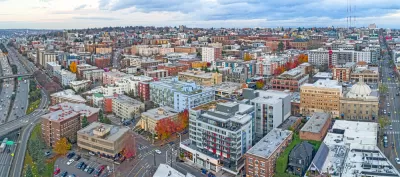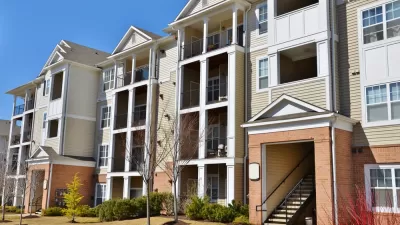Everything you've ever wanted to know about inclusionary zoning: its history, its position in the debate about the future of cities, and its promise as a solution to the nation's housing crisis.

"Increasingly, cities are formalizing the requirement that new residential development include a percentage of affordable homes, the policy known as inclusionary housing," writes Anthony Flint.
Flint positions inclusionary zoning as a policy compromise that bridges the political platforms of pro-development YIMBYs and low-income communities and social justice advocates concerned about the gentrification and displacement effects of new development.
Inclusionary zoning also strikes a compromise in balancing the carrots and sticks of policy. For examples of carrots, Flint writes, "Given the high price of urban land, which makes housing so expensive, many cities are supplementing inclusionary requirements with direct actions such as providing government-owned land for affordable housing." A Sound Transit program in Seattle exemplifies that approach.
For sticks, Flint cites examples in New Jersey and Massachusetts: "Courts in New Jersey have for decades enforced the state’s 'fair share' housing laws, stemming from the landmark Mount Laurel decisions. In Massachusetts, under Chapter 40-B, housing gets fast-tracked if municipalities fail to maintain at least 10 percent of their housing stock as affordable to those earning 80 percent of median area income."
Writing for the Lincoln Institute of Land Policy, Flint also identifies land value capture as the foundation of the inclusionary zoning mandate— "[allowing] the public to recover some of the increased property value enjoyed by landowners as the result of government actions like rezoning."
This feature-length article includes a historical narrative about the rise of NIMBY and YIMBY politics; analysis of the complexities of inclusionary zoning, and how it responds to a complex political environment; numerous examples of inclusionary zoning policies around the country; and frequent references to literature supporting the thinking described in the article.
FULL STORY: Backyard Brouhaha

Alabama: Trump Terminates Settlements for Black Communities Harmed By Raw Sewage
Trump deemed the landmark civil rights agreement “illegal DEI and environmental justice policy.”

Planetizen Federal Action Tracker
A weekly monitor of how Trump’s orders and actions are impacting planners and planning in America.

The 120 Year Old Tiny Home Villages That Sheltered San Francisco’s Earthquake Refugees
More than a century ago, San Francisco mobilized to house thousands of residents displaced by the 1906 earthquake. Could their strategy offer a model for the present?

Opinion: California’s SB 79 Would Improve Housing Affordability and Transit Access
A proposed bill would legalize transit-oriented development statewide.

Record Temperatures Prompt Push for Environmental Justice Bills
Nevada legislators are proposing laws that would mandate heat mitigation measures to protect residents from the impacts of extreme heat.

Downtown Pittsburgh Set to Gain 1,300 New Housing Units
Pittsburgh’s office buildings, many of which date back to the early 20th century, are prime candidates for conversion to housing.
Urban Design for Planners 1: Software Tools
This six-course series explores essential urban design concepts using open source software and equips planners with the tools they need to participate fully in the urban design process.
Planning for Universal Design
Learn the tools for implementing Universal Design in planning regulations.
Clanton & Associates, Inc.
Jessamine County Fiscal Court
Institute for Housing and Urban Development Studies (IHS)
City of Grandview
Harvard GSD Executive Education
Toledo-Lucas County Plan Commissions
Salt Lake City
NYU Wagner Graduate School of Public Service





























